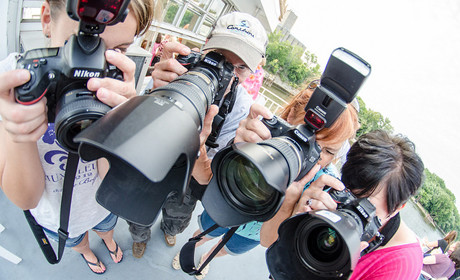
Reporters are now increasingly being asked to come back to the newsroom with photos and videos on top of a written story, so where does this leave specialised photographers?
Neil White, editor-in-chief of the Burton Mail and Derby Telegraph, said there are concerns around the future of the qualified photographer in a way the media industry does not worry about reporters.
"Media organisations haven't always preserved photographers because photographers haven't always proven that they're essential," he said at the NCTJ Journalism Skills conference yesterday.
Speaking on a panel addressing the "changing face of photojournalism", he said photographers need to show that they're an important part of the newsroom by using a multitude of skills.Every position in the newsroom has changedNeil White, editor-in-chief, Burton Mail and Derby Telegraph
As the role of reporters in the newsroom is evolving, photographers also need to "extend the remit" and show they are "indispensable".
“Photographers, they're specialists and we need to protect them,” he added.
“[But] every position in the newsroom has changed, and everybody does take pictures, that's one of our issues at the moment.”
As digital storytelling is evolving and formats like immersive features and audio slideshows become more popular, images are now a key feature on our screens, on every device.
BBC News producer Paul Kerley told conference delegates the broadcaster is "doing pieces now that fill the whole width of the screen”.
“So the quality of photographs, the resolution of photographs, and the way they tell the story is important," he added.
"We're now moving into shorter videos, photographs down the page and also longer form immersive stories that feature photographs heavily to take you through the stories," he said.There's definitely a case that you do have to know video, and come up with story ideasDavid Burner, Caters News Agency
One example of immersive storytelling Kerley highlighted was a feature looking at new islands created by China in the South China Sea, a disputed territory.
Core photography skills are still key for creating such image-heavy online features, but also for producing photographs of the right quality to fit every format and screen size.
David Burner, photo editor and co-owner of Caters News Agency, told conference delegates photographers now have to "multi-train".
"There is a need for specialist photographers, but at the same time [they should be] multi-skilled," he said.
While there is a premium on quality images that stand out, the role of a news photographer has evolved beyond this.
"There's definitely a case that you do have to know video, and come up with story ideas," he said.
Free daily newsletter
If you like our news and feature articles, you can sign up to receive our free daily (Mon-Fri) email newsletter (mobile friendly).
Related articles
- Seven sources of free images for journalists
- Reuters publishes book to honour life of late photojournalist Danish Siddiqui
- Five golden rules for using images to engage readers with your story
- Tip: Safety tips for photojournalists in the time of covid-19
- Solutions photojournalism: “If you can capture all the problems with a photo, why can’t you capture the solutions?"











